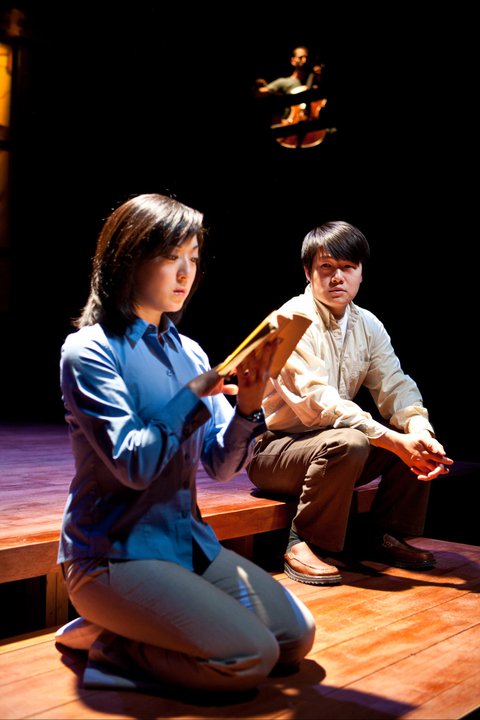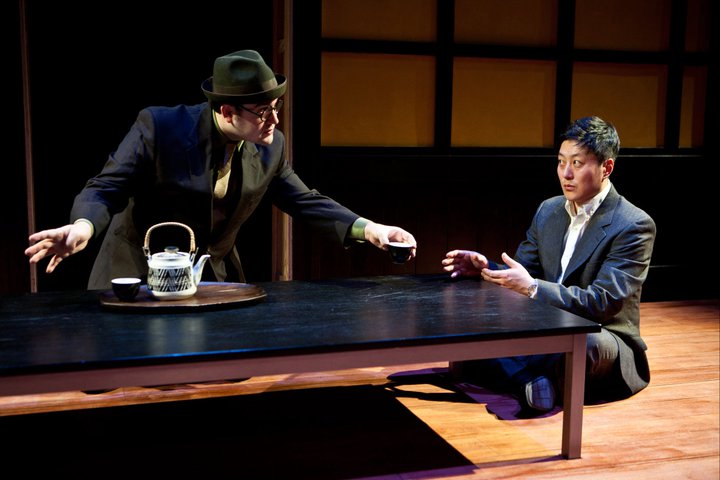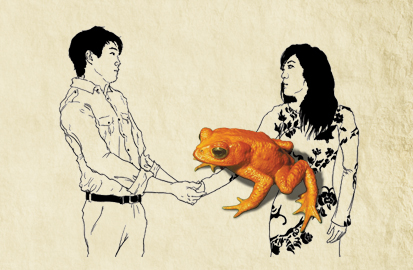Tokyo, Minnesota
Theater critic Christy DeSmith reviews Walking Shadow Theatre's unexpectedly timely production, "After the Quake," adapted for the stage from two novellas by Haruki Murakami reflecting on the 1995 earthquake in Kobe, Japan .




THE LATEST PRODUCTION FROM WALKING SHADOW THEATRE COMPANY is based on two short stories by Japanese author Haruki Murakami. The setting is Tokyo, the subject earthquakes. For me, though, the production conjures an additional (and irrational) sense of place: Minneapolis.
That’s because my reactions to After the Quake are inseparable from my feelings for the City of Lakes, a place to which I’ve just returned after a yearlong turn in Boston. A humble production, After the Quake is rendered with simple costumes, a minimal set, lush lighting, and naturalistic actors. Yet it inspired in me bigger feelings than the all past year’s worth of corporate- and campus-sponsored theater I’ve seen combined. Of course, Boston is no hub when it comes to live theater, but still — it’s so good to be home.
After the Quake is an exemplary small production, the kind of performance essential to the ecosystem of a vibrant arts community like ours. For starters, the show is staged at the People’s Center Theater, a jewel box of a venue situated on the third floor of an inconspicuous brick building. Sitting there, you get the feeling of lounging in an artist’s private parlor or living room. The tiny house facilitates a more intimate, nuanced approach to live performance — something that complements the rich interiority of Murakami’s characters.
Every now and again, an artist finds herself immersed in a project that suddenly echoes real life. Adapted by playwright Frank Galati for Chicago’s Steppenwolf Theatre Company in 2005, After the Quake represents Murakami’s response to the 1995 Kobe earthquake. Writing in the program notes, director Amy Rummenie explains that Walking Shadow had already chosen to do the show when the recent earthquake and tsunami ravaged northeastern Japan. It seems the artistic team paused to consider the ramifications of producing so topical a work. Rummenie and company made a quietly heroic decision to avoid heavy handed reference to the current catastrophe — they didn’t burden the script with any additional messaging, political or otherwise. They simply trusted that well-written material could succeed on its own merits.
Like the best of Murakami stories, the cast makes economical use of language and gesture. A versatile actor, Kurt Kwan wears his hair spiky to play Takatsuki, the swaggering Lothario at the periphery of the romantic short “Honey Pie.” Later, a tidy comb-over and a necktie are all he needs to become Katagiri, the star of surrealist “Superfrog Saves Tokyo,” an uptight collections agent who conspires with a talking amphibian (played by Brant Miller, in oversize green gloves) to save the world from a regenerating worm that’s wreaking havoc underground. This, in particular, strikes me as a brilliant observation: Earthquakes leave even grownup victims grasping for origin stories.
“Honey Pie” courses with the center-of-the-universe heaviness familiar to those in the midst of high-stakes romantic pursuits. Eric Sharp portrays Junpei, a broody and, frankly, unlikable writer who never musters the courage to express his affections for the bookish Sayoko (Katie Bradley). So, the fearless Takatsuki pursues her instead. If theirs isn’t exactly true love, at least Sayoko and Takatsuki’s marriage produces something of value … the occasion for an adorable child actor. Kindergartner Natalie Tran plays Sala, the couple’s daughter, who suffers nightmares in the aftermath of the scary quake. She’s a charmer, and her presence infuses the show with sweetness.
______________________________________________________
After the Quake couldn’t be farther from corporate theater born of focus groups and trend-chasing marketing departments. This kind of miniature, the sort of show vital to our arts ecosystem in the Twin Cities, is wrought from little more than intelligence, great taste in literature, and the purest of intentions.
______________________________________________________
A few words about the structure of the script: The original Murakami short stories, “Honey Pie” and “Superfrog,” are tonally distinct tales with common tremors — of both the tectonic and nightmare varieties. Galati’s adaptation layers the stories chapter-style, leaving the viewer to appreciate the likeness between personal and natural disasters.
The thing I admire most about the writing is how the stage adaptation uses narration to capture Murakami’s beautiful prose. What’s more, this narration allows us inside the heads of these characters — especially Junpei, who’s worse than a typical scaredy-cat; he’s also a slacker on personal matters. Thanks to the cool and impressionistic performances by the cast, these narrative signposts weave seamlessly with the play’s poetic dialogue.
So — I’m not particularly fond of the Junpei character, but I admired the show’s every other facet. Composer Cory P. Grossman provides live accompaniment on cello: simple melodies and rhythms that color the mood. Designed by Steve Kath, the stylish set consists of only two things: a table with retractable legs that forms a bed and a Kotatsu table, and a wall of shoji-style panels. Lighting design by Peter W. Mitchell casts an ethereal glow upon these attractive screens; more powerful, though, are Mitchell’s silos of spotlight that shine on the play’s terrified characters.
Sure, After the Quake left me thinking about natural disaster — its messiness, its requirement of superhuman perseverance, the way it ups the urgency of human relationships. Not to belittle the devastation of those who’ve endured such tragedies, but the show also left me thinking about the nature of art, another thing that fosters empathy between persons. This isn’t the case with corporate art — stuff born of focus groups and trend-chasing marketing departments. The sort of creative empathy I’m talking about is what you get with miniatures like After the Quake, a show wrought from little more than intelligence, great taste in literature, and the purest of intentions. I don’t mean to indulge in hyperbole — when the lights came up, it would be going too far to say I was wholly enamored. Like the production, my response to it was modest. But I was filled with warmth and goodwill for these theater-makers, not to mention the city, that sows art so lovely as this.
______________________________________________________
Related performance details:
After the Quake, presented by Walking Shadow Theatre Company, is on stage through May 21 at the People’s Center Theater in Minneapolis.
______________________________________________________
About the author: After a yearlong stint in Boston, Christy DeSmith just returned to the freelance life in Minneapolis. Formerly an editor at The Rake and Mpls.St.Paul magazines, DeSmith now writes about art, performance, culture, and interesting personalities for a handful of local and national titles.